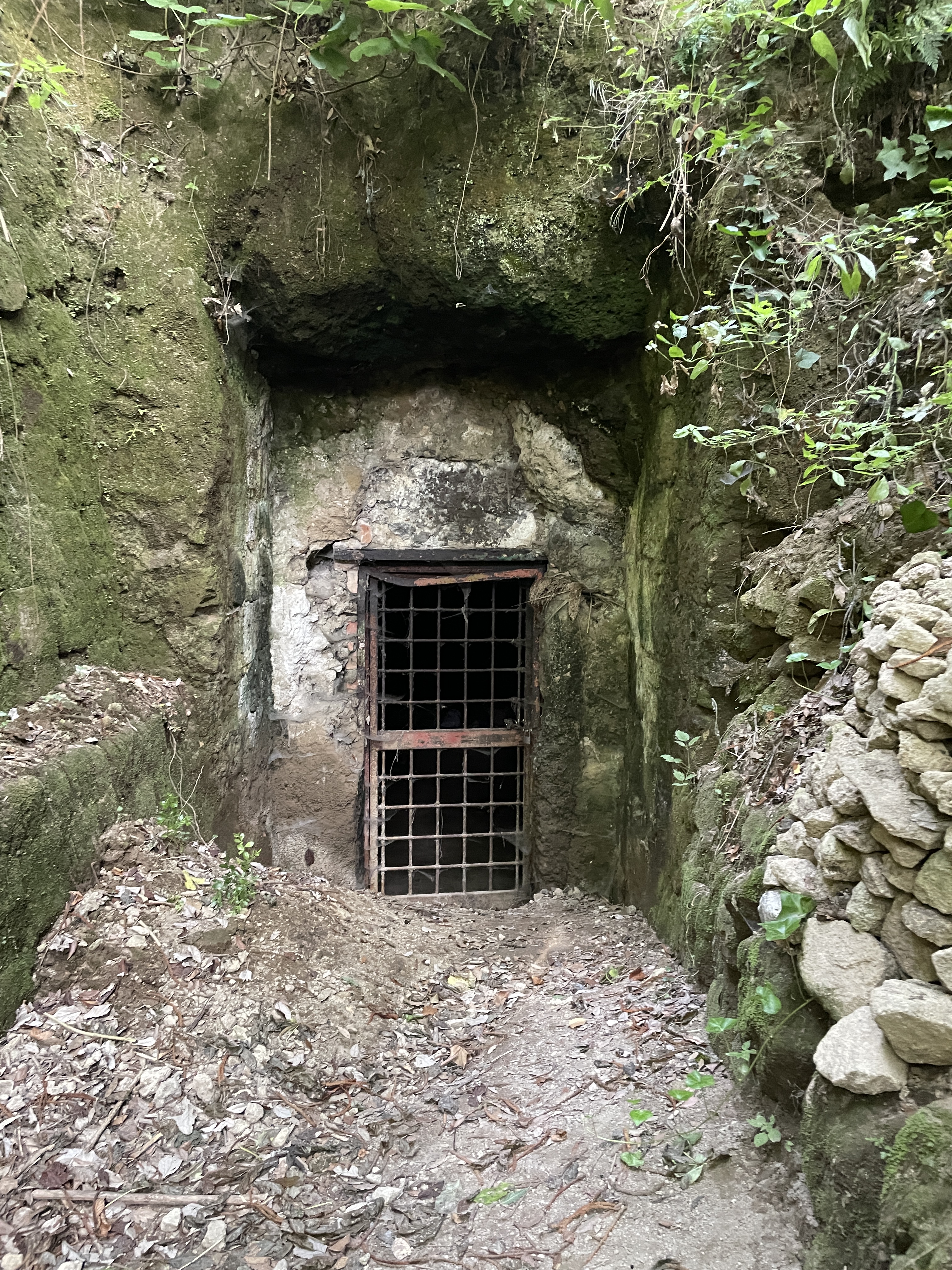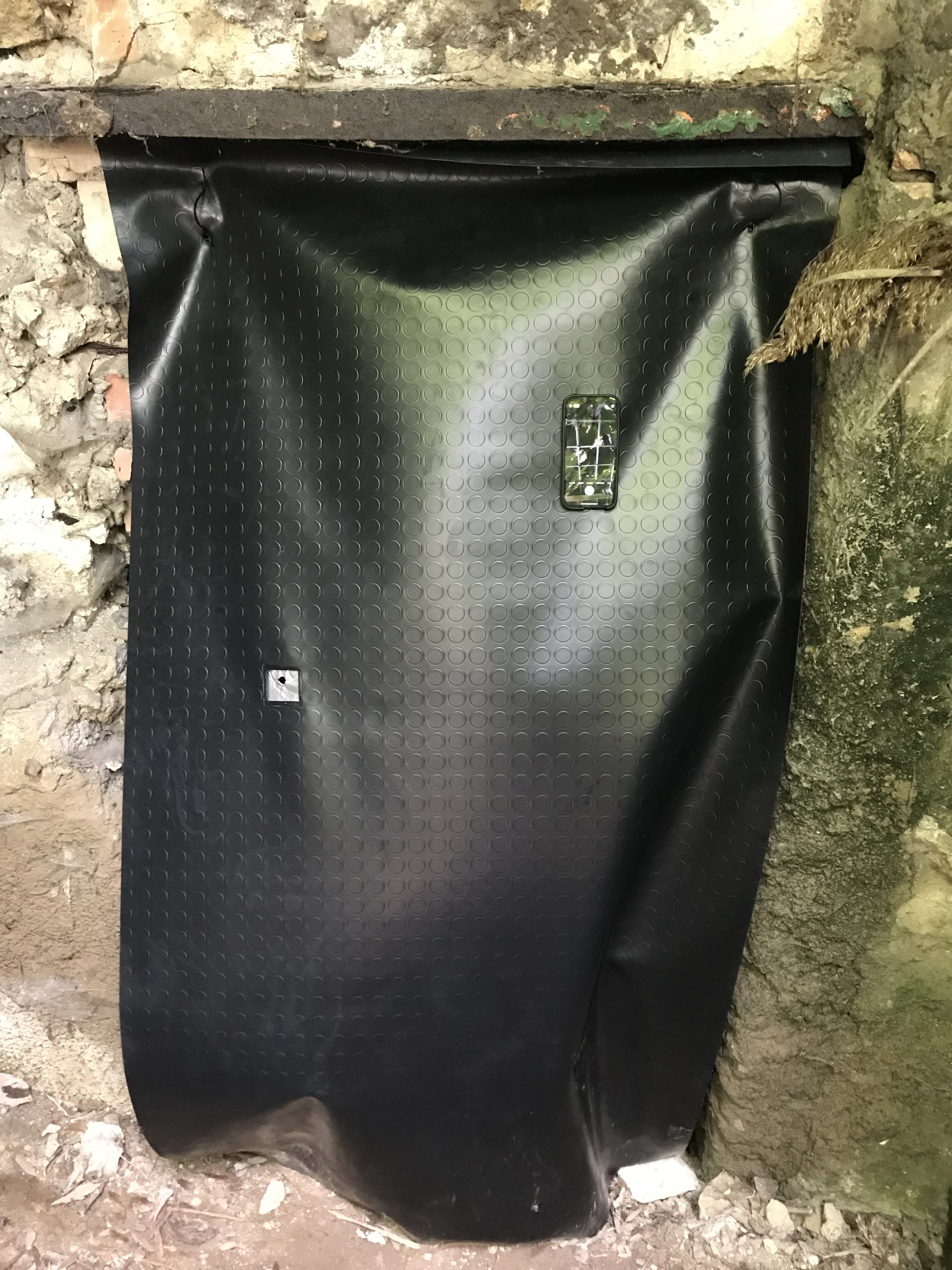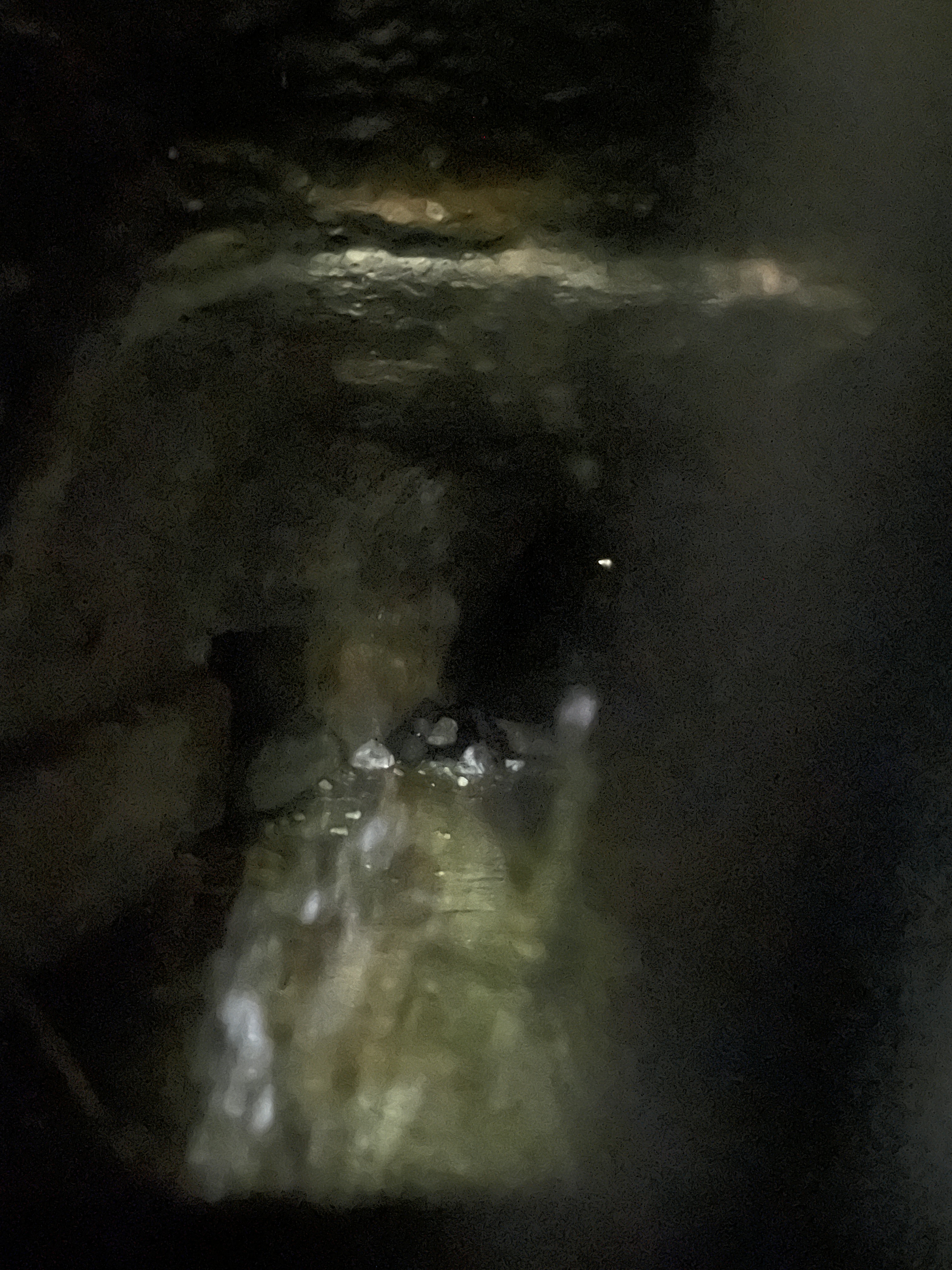For reasons I won’t get too deeply into just yet, last July my friend Deb Chachra and I – as a preliminary study for a place-entangled (and personally haunted) artwork called The Eye Is a Cave by Other Means – converted the gates of hell into a camera obscura.

By ‘gates of hell’, I mean the grilled mouth of the Grotta della Sibilla (the Cave of the Sibyl): a partially flooded tunnel complex transecting the tufa crater wall between Lake Avernus and the puddled remains of Lake Lucrino west of Naples, Italy, that was almost certainly (given the historically constrained use of opus reticulatum inside it, and other visually dateable evidence) constructed – or, at the very least, enlarged and improved – under the direction of military engineer Lucius Cocceius Auctus at the behest of Agrippa during the Roman civil war as part of the construction of the Portus Julius naval complex – the ruins of which are now drowned by Bradyseism in the Tyrrhenian Sea, but shallowly; from a height, whenever clouds pass over, they become visible again, as dark rectilinear shapes in the water.
I won’t argue here exactly why I believe this tunnel mouth – which has, for twenty centuries (excepting only those in which it was covered by volcanic ejecta and temporarily unremembered, before the anamnesis of Bourbon-era archaeology), been popularly associated with the Aeneid (to the extent that entering it by torchlight, piggybacked on a local cicerone through the flooded bits, became a box to tick on the Grand Tour) – was the actual physical model that Virgil (who lived in Naples during its construction) had in mind for the ingress to Hades he described the Sibyl of Cumae leading Aeneas down through in Book VI of his poem (or why this topographical choice was predicated on a centuries-long tradition Virgil had inherited, that the liminal shore of the ‘Cimmerian lands’ Odysseus disembarks at to begin his own necromantic katabasis in Book XI of Homer’s Odyssey is that of Avernus; or why Dante hews so closely to the general topography of Aeneid Book VI in the first three cantos of his Inferno, despite dialing its toponymic specificity down to the point of allegory – speaking of which, don’t even get me started about the geographical overlap between the Homeric Nekyia and that of Plato’s cave). Suffice it to say that I can, and have, and will again, but elsewhere.
Nor will I delve into the many other ‘triple rhymes’ that connect Homer’s Odyssey, Virgil’s Aeneid, and Dante’s Commedia. Not even the scene in each poem where a living interloper among the dead thrice tries, and thrice fails, to embrace the eidolon (the ghost or, per Plato, mental image/memory) of a loved one: mother, father, and dear friend, respectively.
[Cue Johnny Thunders.]
For now, the whys notwithstanding, I want to show you a bit of what we did.
Before relocating to Naples for field work last summer, I had to provide my supervisory committee with a package of materials for what the UK higher education system refers to, somewhat euphemistically, as an ‘upgrade’. This is analogous to US comprehensive examinations, inasmuch (but only inasmuch, really) as it determines whether you are to be ‘upgraded’ from a terminal master’s degree to all-but-dissertation PhD candidacy. Anyhow, in addition to a great many other things I included in that 60-page document, I proposed “to block up the gate [of the Grotta della Sibilla] with cardboard and black garbage bags and turn the tunnel mouth into a camera obscura. Cut and seal around the hole as required with electrical tape. By utilizing a lens over the hole, I can flip the image – which this technique naturally inverts – right way up. Alternatively, depending on how clear the orientation is on film between the grotto floor and ceiling, I can simply flip the recorded image. In this way, I can introduce images/video of [redacted] in the open air, act things out around them, and film this all inside the grotto as shimmering images projected on its walls or, possibly, in the air on a screen made of smoke or mist. To better control the camera position, I can punch a second hole through the covering on the gate, put a GoPro on a stick through it, then seal back around the stick to minimize light leak.”
This is more or less what Deb and I pulled off.
Essentially, we took the set-up for our previous study in the Naples Airbnb and portabilized it. Having previously measured the dimensions of the opening we wanted to light-seal, we cut an appropriate length of black rubber matting from a big roll of the stuff I’d bought on the cheap at a local hardware store. We’d already made a simple oculus: a square of stiff aluminum foil cut from the base of a pie tin with a pencil-gauge hole poked through its center (the smaller the hole, the sharper, but dimmer, the image). Depending on where we would ultimately need to place it (based on available light, the shape of the gridded bars of the gate, the geometry of the walls leading up to it, etc.), we planned to box-cutter open a small square hole in the rubber, then seal the larger tin foil square over it with black electrical tape.
With the rubber rug rolled up like a yoga mat, no one on the train to Lucrino batted an eye.

The iron frame of the gate has been twisted out of shape over the years by people forcing entrance. It’s embedded in a matrix of filthy, friable volcanic rock, partially reinforced with masonry of indeterminate vintage. What’s more, it exhales a strong, persistent draft. In short, fully light-sealing the tunnel mouth with the equipment we had at our disposal wasn’t going to be feasible. One of the things we learned installing the first camera obscura, however, is that the physics of light aren’t precious. If something is going to work, it just does, even when the set-up is primitive or only partial. So, we knew we had some leeway. The question was, how much?

Perforating the rubber along one end, we were able to secure it to the top of the frame with a fistful of zip ties Deb produced from her magic bag of tricks. With chunks of stone, we managed to pin down the bottom of the rug, but because the draft caused it to billow away from the gate, were unable to also seal the sides – requiring one of us to do their best to manually, awkwardly, hold them down while the other person took photographs.


Seeing and documenting the image produced by the camera obscura from outside the locked gate was a matter of cutting another small hole in the rubber and affixing Deb’s iPhone (a newer generation than my antique, capable of producing slightly longer exposures) to it with the electrical tape. As soon as we held it up to the hole, we could see through the photo app view screen that our set-up worked. There, on the black floor of the tunnel, like magic, if not quite clear as day, was a reversed and inverted full-color image of the trees canopied above the little path that leads to the gate.

From Aeneid Book VI:
On they went, hidden in solitary night, through gloom,
through Dis’s empty halls, and insubstantial kingdom,
like a path through a wood, in the faint light
under a wavering moon, when Jupiter has buried the sky
in shadow, and black night has stolen the colour from things.
Right before the entrance,
…
In the centre a vast shadowy elm spreads its aged trunks
and branches: the seat, they say, that false Dreams hold,
thronging, clinging beneath every leaf.
Just saying.
Keeping the camera stable proved difficult. Most of the photos were out of focus, and/or blurred due to movement during the long exposure, and/or of the bars of the gate rather than the image behind them on the floor. Even so, we managed to get a few that make it clear what was going on.
Have a look at these last two shots. (It would be easier to see what I’m describing in side-by-side comparison on a big monitor than sequentially, and on your phone, but we do what we can).


The first is a reference photo I took earlier in the summer (in slightly different lighting and vegetation conditions), from near the gate looking back down the trail toward Lake Avernus. The second – taken with a three-second exposure through a small hole in a wind-flapped rubber mat, a rusty lattice, and a cobweb – is of what we saw projected onto the floor of the grotto. Obviously, but also wonderfully, it’s the same scene. All I’ve done here to make that more legible is to invert the photograph. It helped me to see what I was looking at.
The subsurface wasn’t just a screen we projected an image of the surface onto, it helped us to produce that image: an image co-created with the earth itself.
A pretty good start.
Leave a comment